what does it mean for a molecule to be conjugated
Visible and Ultraviolet Spectroscopy
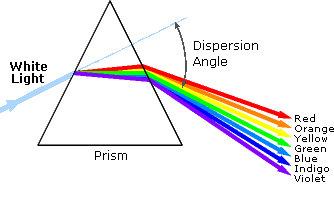
i. Background
An obvious deviation betwixt certain compounds is their color. Thus, quinone is yellowish; chlorophyll is dark-green; the 2,iv-dinitrophenylhydrazone derivatives of aldehydes and ketones range in color from bright yellow to deep red, depending on double bond conjugation; and aspirin is colorless. In this respect the human eye is functioning as a spectrometer analyzing the calorie-free reflected from the surface of a solid or passing through a liquid. Although we come across sunlight (or white lite) as compatible or homogeneous in colour, information technology is really composed of a broad range of radiation wavelengths in the ultraviolet (UV), visible and infrared (IR) portions of the spectrum. Equally shown on the right, the component colors of the visible portion can exist separated by passing sunlight through a prism, which acts to bend the light in differing degrees co-ordinate to wavelength. Electromagnetic radiations such equally visible light is commonly treated as a wave miracle, characterized by a wavelength or frequency. Wavelength is defined on the left below, as the distance betwixt adjacent peaks (or troughs), and may be designated in meters, centimeters or nanometers (10-9 meters). Frequency is the number of wave cycles that travel by a stock-still betoken per unit of time, and is usually given in cycles per second, or hertz (Hz). Visible wavelengths cover a range from approximately 400 to 800 nm. The longest visible wavelength is red and the shortest is violet. Other common colors of the spectrum, in guild of decreasing wavelength, may exist remembered by the mnemonic: ROY Thou BIV. The wavelengths of what we perceive every bit particular colors in the visible portion of the spectrum are displayed and listed below. In horizontal diagrams, such as the i on the bottom left, wavelength will increase on moving from left to right.
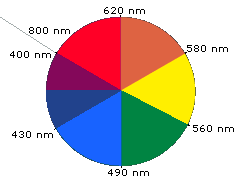
When white light passes through or is reflected by a colored substance, a characteristic portion of the mixed wavelengths is absorbed. The remaining lite will then presume the complementary colour to the wavelength(south) absorbed. This relationship is demonstrated by the color wheel shown on the right. Hither, complementary colors are diametrically contrary each other. Thus, assimilation of 420-430 nm light renders a substance yellow, and absorption of 500-520 nm calorie-free makes it red. Green is unique in that it can be created by absoption shut to 400 nm every bit well as absorption near 800 nm.
Early humans valued colored pigments, and used them for decorative purposes. Many of these were inorganic minerals, but several of import organic dyes were also known. These included the crimson pigment, kermesic acid, the blue dye, indigo, and the yellow saffron pigment, crocetin. A rare dibromo-indigo derivative, punicin, was used to color the robes of the royal and wealthy. The deep orange hydrocarbon carotene is widely distributed in plants, just is not sufficiently stable to be used equally permanent pigment, other than for food coloring. A common feature of all these colored compounds, displayed below, is a system of extensively conjugated pi-electrons.
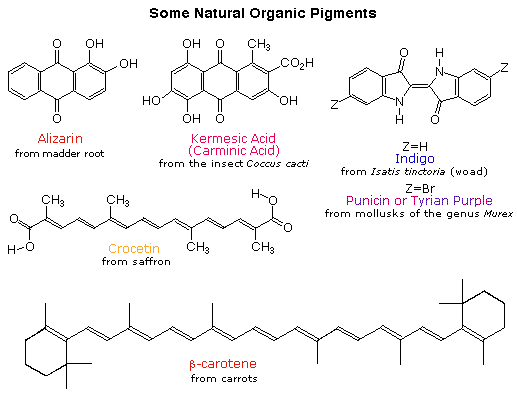
2. The Electromagnetic Spectrum
The visible spectrum constitutes only a small part of the full radiations spectrum. Most of the radiation that surrounds us cannot exist seen, but can be detected by defended sensing instruments. This electromagnetic spectrum ranges from very short wavelengths (including gamma and x-rays) to very long wavelengths (including microwaves and broadcast radio waves). The post-obit chart displays many of the of import regions of this spectrum, and demonstrates the changed human relationship betwixt wavelength and frequency (shown in the top equation below the chart).
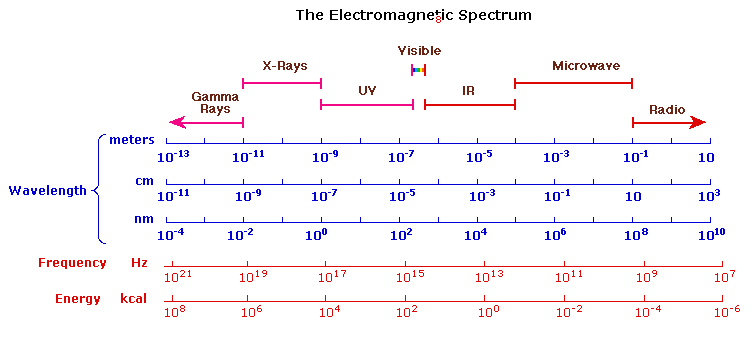
The energy associated with a given segment of the spectrum is proportional to its frequency. The bottom equation describes this relationship, which provides the free energy carried by a photon of a given wavelength of radiation.

To obtain specific frequency, wavelength and energy values use this calculator.
3. UV-Visible Absorption Spectra
To understand why some compounds are colored and others are non, and to make up one's mind the relationship of conjugation to color, we must make accurate measurements of light absorption at different wavelengths in and near the visible part of the spectrum. Commercial optical spectrometers enable such experiments to be conducted with ease, and ordinarily survey both the near ultraviolet and visible portions of the spectrum.
| For a description of a UV-Visible spectrometer Click Here. |
|---|
The visible region of the spectrum comprises photon energies of 36 to 72 kcal/mole, and the near ultraviolet region, out to 200 nm, extends this energy range to 143 kcal/mole. Ultraviolet radiation having wavelengths less than 200 nm is hard to handle, and is seldom used every bit a routine tool for structural assay.
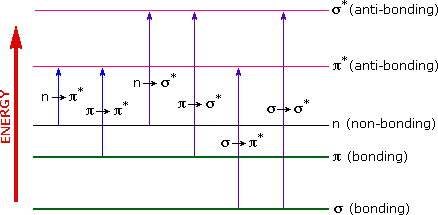
The energies noted above are sufficient to promote or excite a molecular electron to a higher free energy orbital. Consequently, absorption spectroscopy carried out in this region is sometimes called "electronic spectroscopy". A diagram showing the diverse kinds of electronic excitation that may occur in organic molecules is shown on the left. Of the half-dozen transitions outlined, just the two lowest energy ones (left-most, colored blue) are achieved past the energies bachelor in the 200 to 800 nm spectrum. As a dominion, energetically favored electron promotion will be from the highest occupied molecular orbital (HOMO) to the lowest unoccupied molecular orbital (LUMO), and the resulting species is called an excited state. For a review of molecular orbitals click hither.
When sample molecules are exposed to lite having an energy that matches a possible electronic transition inside the molecule, some of the calorie-free energy will be absorbed as the electron is promoted to a higher energy orbital. An optical spectrometer records the wavelengths at which absorption occurs, together with the degree of absorption at each wavelength. The resulting spectrum is presented as a graph of absorbance (A) versus wavelength, as in the isoprene spectrum shown beneath. Since isoprene is colorless, it does not absorb in the visible function of the spectrum and this region is not displayed on the graph. Absorbance usually ranges from 0 (no assimilation) to 2 (99% absorption), and is precisely defined in context with spectrometer operation.
Considering the absorbance of a sample will be proportional to the number of absorbing molecules in the spectrometer calorie-free beam (e.grand. their molar concentration in the sample tube), information technology is necessary to correct the absorbance value for this and other operational factors if the spectra of different compounds are to exist compared in a meaningful mode. The corrected absorption value is called "molar absorptivity", and is specially useful when comparing the spectra of dissimilar compounds and determining the relative strength of light absorbing functions (chromophores). Molar absorptivity (ε) is defined as:
| Molar Absorptivity, ε = A / c l | (where A= absorbance, c = sample concentration in moles/liter & l = length of light path through the sample in cm.) |
|---|
If the isoprene spectrum on the right was obtained from a dilute hexane solution (c = 4 * 10-v moles per liter) in a 1 cm sample cuvette, a simple calculation using the above formula indicates a molar absorptivity of 20,000 at the maximum absorption wavelength. Indeed the entire vertical absorbance calibration may be inverse to a molar absorptivity scale one time this information about the sample is in hand. Clicking on the spectrum will brandish this alter in units.
| 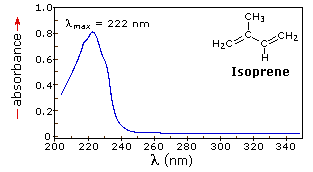 |
From the chart to a higher place it should exist clear that the simply molecular moieties probable to absorb light in the 200 to 800 nm region are pi-electron functions and hetero atoms having non-bonding valence-shell electron pairs. Such light absorbing groups are referred to as chromophores. A listing of some simple chromophores and their low-cal absorption characteristics is provided on the left to a higher place. The oxygen non-bonding electrons in alcohols and ethers do not give rise to absorption above 160 nm. Consequently, pure alcohol and ether solvents may be used for spectroscopic studies.
The presence of chromophores in a molecule is best documented by UV-Visible spectroscopy, merely the failure of virtually instruments to provide absorption data for wavelengths below 200 nm makes the detection of isolated chromophores problematic. Fortunately, conjugation more often than not moves the assimilation maxima to longer wavelengths, as in the case of isoprene, then conjugation becomes the major structural feature identified past this technique.
Molar absorptivities may exist very large for strongly absorbing chromophores (>ten,000) and very small-scale if assimilation is weak (10 to 100). The magnitude ofε reflects both the size of the chromophore and the probability that light of a given wavelength will exist absorbed when it strikes the chromophore.
| For further word of this topic Click Here. |
|---|
4. The Importance of Conjugation
A comparing of the absorption spectrum of ane-pentene, λmax = 178 nm, with that of isoprene (higher up) conspicuously demonstrates the importance of chromophore conjugation. Farther evidence of this effect is shown below. The spectrum on the left illustrates that conjugation of double and triple bonds also shifts the absorption maximum to longer wavelengths. From the polyene spectra displayed in the center diagram, it is articulate that each additional double bond in the conjugated pi-electron system shifts the absorption maximum about xxx nm in the same direction. Besides, the molar absorptivity (ε) roughly doubles with each new conjugated double bond. Spectroscopists use the terms divers in the table on the right when describing shifts in absorption. Thus, extending conjugation more often than not results in bathochromic and hyperchromic shifts in absorption.
The advent of several assimilation peaks or shoulders for a given chromophore is common for highly conjugated systems, and is oft solvent dependent. This fine construction reflects non simply the different conformations such systems may assume, but also electronic transitions betwixt the unlike vibrational energy levels possible for each electronic state. Vibrational fine construction of this kind is virtually pronounced in vapor phase spectra, and is increasingly broadened and obscured in solution as the solvent is changed from hexane to methanol.
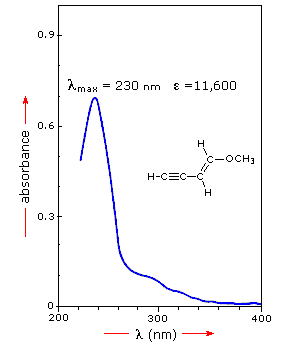 | 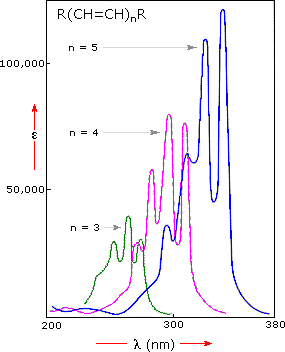 | Terminology for Absorption Shifts
|
|---|
To understand why conjugation should cause bathochromic shifts in the assimilation maxima of chromophores, nosotros demand to look at the relative energy levels of the pi-orbitals. When two double bonds are conjugated, the 4 p-atomic orbitals combine to generate four pi-molecular orbitals (ii are bonding and two are antibonding). This was described earlier in the section concerning diene chemical science. In a similar manner, the three double bonds of a conjugated triene create six pi-molecular orbitals, half bonding and half antibonding. The energetically most favorable π __> π* excitation occurs from the highest free energy bonding pi-orbital (Man) to the lowest energy antibonding pi-orbital (LUMO).
The following diagram illustrates this excitation for an isolated double bond (only 2 pi-orbitals) and, on clicking the diagram, for a conjugated diene and triene. In each example the HOMO is colored bluish and the LUMO is colored magenta. Increased conjugation brings the Homo and LUMO orbitals closer together. The energy (ΔE) required to result the electron promotion is therefore less, and the wavelength that provides this energy is increased correspondingly (think λ = h • c/ΔE ).
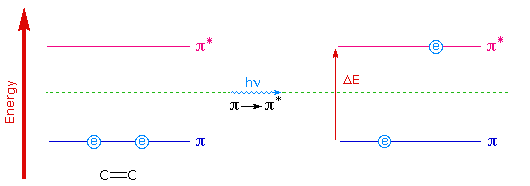 |
| Examples of π __> π* Excitation |
|---|
Many other kinds of conjugated pi-electron systems human action equally chromophores and absorb calorie-free in the 200 to 800 nm region. These include unsaturated aldehydes and ketones and effluvious ring compounds. A few examples are displayed beneath. The spectrum of the unsaturated ketone (on the left) illustrates the advantage of a logarithmic display of tooth absorptivity. The π __> π* assimilation located at 242 nm is very strong, with an ε = 18,000. The weak n __> π* absorption about 300 nm has an ε = 100.
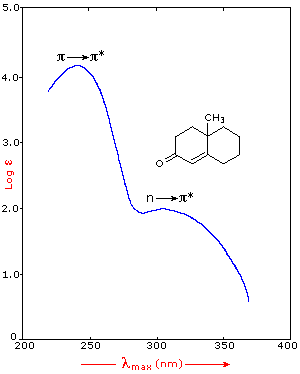 | 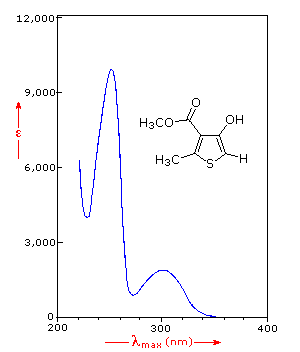 |
|---|
Benzene exhibits very strong calorie-free assimilation almost 180 nm (ε > 65,000) , weaker absorption at 200 nm (ε = eight,000) and a grouping of much weaker bands at 254 nm (ε = 240). But the last group of absorptions are completely displayed because of the 200 nm cut-off characteristic of nigh spectrophotometers. The added conjugation in naphthalene, anthracene and tetracene causes bathochromic shifts of these absorption bands, equally displayed in the nautical chart on the left below. All the absorptions practise not shift past the same amount, then for anthracene (dark-green shaded box) and tetracene (bluish shaded box) the weak absorption is obscured past stronger bands that accept experienced a greater reddish shift. As might be expected from their spectra, naphthalene and anthracene are colorless, merely tetracene is orangish.
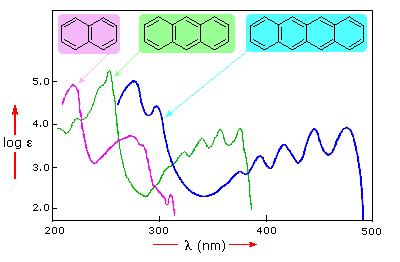 | 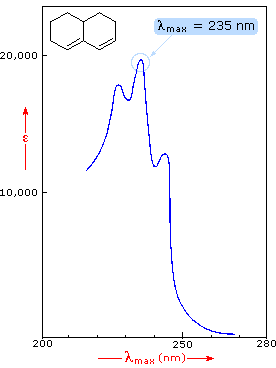 |
|---|
The spectrum of the bicyclic diene (in a higher place right) shows some vibrational fine structure, but in general is similar in advent to that of isoprene, shown to a higher place. Closer inspection discloses that the absorption maximum of the more highly substituted diene has moved to a longer wavelength by about 15 nm. This "substituent effect" is general for dienes and trienes, and is even more pronounced for enone chromophores.
| A ready of empirical rules for predicting the λmax of such chromophores has been developed. |
|---|
| Render to Tabular array of Contents |
|---|
This page is the property of William Reusch. Comments, questions and errors should be sent to whreusch@msu.edu.
These pages are provided to the IOCD to assist in capacity building in chemic teaching. 05/05/2013
![]()
Source: https://www2.chemistry.msu.edu/faculty/reusch/VirtTxtJml/Spectrpy/UV-Vis/spectrum.htm
0 Response to "what does it mean for a molecule to be conjugated"
Postar um comentário